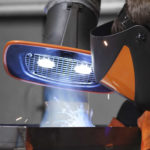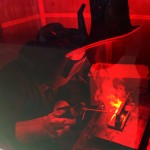Welding of structural steel: Danger from particulate and gaseous hazardous substances
In the context of welding work, the filler material – and only to a lesser extent the base material – releases hazardous particulate substances. Depending on the process, gaseous hazardous substances can also be produced by chemical reactions from the air or the protective gas. One example is the welding of structural steel: Electric welding of this base material releases hazardous particulate substances (fumes), whereas oxyacetylene welding presents more of a gas hazard.
The term structural steels is a group designation for low-carbon non-alloyed or low-alloy steels that are not heat-treated or only partially heat-treated. They are also differentiated according to a variety of strength classes and other categories. Structural steels are very popular in many industries today. They are used in construction, mechanical engineering, ducting system construction, shipbuilding, bridge building and offshore wind turbines to mention but a few. Structural steels are comparatively cheap and versatile due to their excellent properties (e.g. mechanical strength and toughness). The most important joining method for structural steels is welding.
Structural steel can be processed with almost all welding methods. Depending on the welding process used, the base material is thermally influenced differently in the heat-affected zone. It is the heating and, in the case of gas-shielded welding, primarily the melting of the welding wire in the hot arc that first produces the hazardous substances and the welding fumes.
Iron oxides as a hazard when welding structural steel
One of the main hazards in welding structural steel comes from iron oxides – more precisely from iron(II) oxide and iron(III) oxide. They belong to the group of particulate substances that are harmful to the lungs, but have no toxic or carcinogenic effect. The intake of high concentrations of iron oxide over a long period of time can lead to a build-up of dust in the lungs. Such a deposit is also known as iron dust lung or pulmonary siderosis.
Iron deposits usually disappear after a certain time – if the welder is not exposed. However, at very high concentrations over several years and in poor air conditions, serious diseases can occur. For example, fibrogenic reactions (connective tissue proliferation) of the lungs can occur. This causes the tissue to harden and can lead to the restriction of organ function. It is accompanied by chronic inflammation of the lung connective tissue, which also affects the fine walls of the alveoli.
Toxic and hazardous to health: Manganese in structural steel
A further danger for welders is manganese oxides that are formed from the manganese contained in the steel. The transition metal is required for strength and weldability in structural steels. In high concentrations, manganese oxides can irritate the respiratory tract and lead to pneumonia. They even damage the nervous system with chronic exposure.
Welding of structural steel: The process and alloy are decisive
Depending on the welding process, additives and alloying elements, the composition of the welding fumes changes and, thus, also the type and quantity of hazardous substances. If the structural steel is alloyed with copper, for example, the welding fumes may contain copper oxide, whereas zinc oxide is produced when galvanised components are welded. Here is a selection of common processes for the welding of structural steel:
- Gas welding: With the gas welding of structural steels, there is a particular danger of nitrous gases, i.e. nitrogen oxides. At the edge of the hot oxyfuel flame, the nitrogen reacts with the atmospheric oxygen and leads to the formation of nitrogen oxides. The more confined the working spaces in which welding takes place, the greater the hazards welders expose themselves to. Nitrous gases can cause poisoning and lung damage after inhalation.
- Metal active gas welding with carbon dioxide (MAGC): Using the MAGC process when welding structural steel initially produces welding fumes that consist mainly of iron oxides. At the same time, carbon monoxide also represents a major component. It is produced by the thermal decomposition of carbon dioxide – because that is used as a protective gas in this process.
- Metal active gas welding with mixed gas (MAGM): Similar to MAGC welding, this process also produces welding fumes that contain iron oxide. If carbon dioxide is used as a mixed gas, there is also a risk of exposure to carbon monoxide.
- Electric arc welding: Compared to gas welding, electric arc welding with stick electrodes is especially subject to the danger of hazardous substances in the form of particulates. The welding fumes are mainly composed of iron(III) oxide – in addition, there are other substances released from the various coatings.
Welding smoke detection required at the source
No matter which process is used for welding structural steel: The capture of hazardous substances at the source of origin by means of effective extraction technology is absolutely essential in any case. It is important that the hazardous substances are extracted as far as possible and that they are safely discharged into a filter system with a high degree of efficiency. However, welders should note that hazardous gaseous substances cannot be effectively filtered out.
In truth, they must be kept within limits by appropriate dilution. This is done using a certain amount of outside air, which often already results from the movement of people and goods. Alternatively, it is possible to direct part of the extracted air outside as exhaust air. The design of the systems depends on the materials and welding processes used as well as the on-site working situation.






